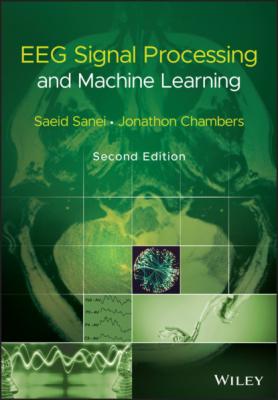EEG Signal Processing and Machine Learning. Saeid Sanei
Читать онлайн.| Название | EEG Signal Processing and Machine Learning |
|---|---|
| Автор произведения | Saeid Sanei |
| Жанр | Программы |
| Серия | |
| Издательство | Программы |
| Год выпуска | 0 |
| isbn | 9781119386933 |
Later in Chapter 11 of this book we will show the application of this recording modality in detection of interictal epileptiform discharges (IEDs) from the hippocampus.
With the advances in microelectronics and microsensor designs, a new type of microsensor array insertable into the brain blood vessels within the motor cortex without any open surgery has been designed. The sensor array, called Stentrode™ is a small metallic mesh tube (stent), with not more than 4 mm diameter and with electrode contacts (small metal discs) within the stent structure.
The Stentrode™ (Figure 2.10) is expected to accurately record the neuronal activities within motor area and therefore help patients with loss of motor function due to paralysis from spinal cord injury, motor neuron disease, stroke, muscular dystrophy, or loss of limbs.
Figure 2.7 Electrocorticography.
Figure 2.8 Foramen ovale holes within facial skeleton.
Figure 2.9 Foramen ovale electrodes.
2.2.4 Conditioning the Signals
The raw EEG signals have amplitudes of the order of μV and contain frequency components of up to 300 Hz. To retain the effective information the signals have to be amplified before the ADC and filtered, either before or after the ADC, to reduce the noise and make the signals suitable for processing and visualization. The filters are designed in such a way not to introduce any change or distortion to the signals. Highpass filters with cut‐off frequency of usually less than 0.5 Hz are used to remove the disturbing very low frequency components such as those of breathing. Conversely, high‐frequency noise is mitigated using lowpass filters with cut‐off frequency of approximately 50–70 Hz. Notch filters with the null frequency of 50 Hz are often necessary to ensure perfect rejection of the strong 50 Hz power supply. In this case the sampling frequency can be as low as twice the bandwidth as commonly used by most EEG systems. The commonly used sampling frequencies for EEG recordings are 100, 250, 500, 1000, and 2000 samples per second. The main artefacts can be divided into patient related (physiological) and system artefacts. The patient related or internal artefacts are body movement‐related, EMG, ECG (and pulsation), EOG, ballistocardiogram, and sweating. The system artefacts are 50/60 Hz power supply interference, impedance fluctuation, cable defects, electrical noise from the electronic components, and unbalanced impedances of the electrodes. Often in the preprocessing stage these artefacts are highly mitigated and the informative information is restored. Some methods for removing the EEG artefacts will be discussed in the related chapters of this book. Figure 2.11 shows a set of normal EEG signals affected by eye‐blinking artefact. Similarly, Figure 2.12 represents a multichannel EEG set with clear appearance of ECG signals over the electrodes in the occipital region.
Figure 2.10 A 4‐mm diameter Stentrode with electrode contacts within the stent structure.
In the following sections we highlight the most popular changes in EEG measurements which correlate with physiological and mental abnormalities in the brain.
2.3 Sleep
Brain waves change during the various stages of normal sleep. When sleep starts the high‐frequency waveforms gradually die away and continuous slow waves (in the delta band) followed by spindles and K‐complexes appear from stage two of sleep and extend towards stage four. During the last stages of sleep rapid eye movement (REM) starts and finishes before the person wakes up. All these stages can be observed and accurately detected and scored automatically by analyzing the EEG signals during normal sleep.
Figure 2.11 A set of normal EEG signals affected by an eye‐blinking artefact.
Conversely, there are cases where the subject has sleep disorder. These include obstructive sleep apnoea (OSA), insomnia (including parainsomnia and hyperinsomnia), REM sleep behaviour disorder, circadian rhythm sleep disorders, non‐24‐hour sleep–wake disorder, periodic limb movement disorder (PLMD), shift work sleep disorder, narcolepsy. Sleep disorders need to be diagnosed and treated.
Such disorders are often detected, monitored, or diagnosed through other recording modalities such as heartrate and respiration. Nevertheless, the use of sleep EEG in detection or monitoring of abnormal sleep has been a topic of research recently. Some methods are discussed in the related chapter of this book.
Figure 2.12 A multichannel EEG set with the clear appearance of ECG signals over the electrodes in the occipital region.
2.4 Mental Fatigue
Mental fatigue is often the result of prolonged cognitive load and can negatively affect people over a short or long time and can cause failure of the brain in performing its regular tasks. Mental fatigue mainly affects the function of the brain network rather than changing the normal brain rhythms significantly [21, 22] In these studies it has been shown that there is less synchrony between the left and right brain lobes and less connectivity between various brain lobes when the brain is under mental fatigue.
Mental fatigue also deteriorates the brain response to audio, visual, and other stimulations by attenuating and time shifting the ERPs. It has been shown that the amplitude of ERP (particularly P3b which is a subcomponent of P300,) reduces and the ERP latency, particularly for P3b, increases with the increase in mental fatigue [23–25].
A chapter of this book is devoted to detailed analysis of the EEG for under fatigue brains.
2.5 Emotions
The brain right hemisphere is associated with emotions. Lateralized electrophysiological parameters measured during emotionally charged states found relative activation (as measured by decreased alpha power) using EEG during the recollection of past events associated with anger or relaxation. Similar findings were obtained during self‐reported emotional reactions to visual material [26]. Other experimental studies have verified the relative right‐hemisphere activation
